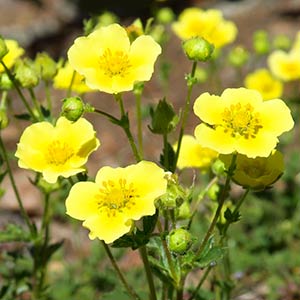Drymocallis arizonica
Drymocallis pseudorupestris
Arizona drymocallis or wood beauty
cliff drymocallis, cliff woodbeauty, false rock loving cinquefoil, Rocky Mountain sticky cinquefoil
short.
elongate.
± tufted, (1.5–)2.5–6 dm;
base 1.5–2.5 mm diam., sparsely to densely septate-glandular.
openly tufted to loosely spaced, (0.3–)0.6–4 dm;
base 1–3 mm diam., ± densely septate-glandular.
sparsely to moderately hairy;
basal 5–22 cm, leaflet pairs (2–)3–4(–5);
terminal leaflet broadly obovate-elliptic, 1–5 × 1–2.5(–4) cm, teeth double, 6–18 per side, apex rounded to acute;
cauline 1–4, well developed, leaflet pairs 2–3.
glabrate or sparsely to ± densely hairy;
basal (2–)3–16 cm, leaflet pairs (2–)3–4(–5);
terminal leaflet broadly obovate-cuneate to flabellate, 0.2–3(–4) × 0.5–3 cm, teeth single or double, 2–15 per side, apex usually rounded to truncate, sometimes obtuse;
cauline 0–2, reduced, leaflet pairs 2–3.
5–30-flowered, not notably leafy, compact, 1/10–1/4(–1/2) of stem, narrow, branch angles 5–25°.
2–40-flowered, not or ± leafy, open, 1/6–3/4(–4/5) of stem, ± wide, branch angles (10–)20–40(–50)°.
1–10 (proximal to 20) mm, sparsely to ± densely short-hairy, predominantly septate-glandular.
3–20 (proximal to 40) mm, not or sparsely to moderately short-hairy, predominantly septate-glandular.
opening widely;
epicalyx bractlets linear-lanceolate to narrowly elliptic, 2–4(–7) × 1–2 mm;
sepals spreading, 4–6(–11) mm, apex ± acute;
petals not or scarcely overlapping, spreading, cream-white, ± obovate, 3–6 × 2.5–5 mm, shorter than or equal to sepals;
filaments 1–3 mm, anthers 0.7–1 mm;
styles thickened, 1 mm.
opening widely;
epicalyx bractlets linear to elliptic, 2–6 × 1–2 mm;
sepals spreading, 4–7(–9) mm, apex acute to obtuse, apiculate;
petals overlapping or not, spreading, cream-white to pale yellow (red-tinged in var. crumiana), narrowly to broadly obovate, 4–12 × 3–11 mm, longer than sepals;
filaments 1–4 mm, anthers 0.7–1.2 mm;
styles thickened, 1–1.5 mm.
light brown, 1 mm.
light brown, 1 mm.
= 14.
Drymocallis arizonica
Drymocallis pseudorupestris
Drymocallis arizonica encompasses populations in Arizona north of the Mogollon Rim and in Utah as far north as Garfield and Sevier counties, including the Henry Mountains. It is most distinctive in northern Arizona, where plants commonly have basal leaves with four pairs of lateral leaflets and compact inflorescences. The species intergrades with D. convallaria but is in general shorter and more likely multistemmed. It also shares similarities with D. pseudorupestris but has more developed cauline leaves and a more compact inflorescence. The intergrade zone between all three species and D. deseretica in southwestern Utah is particularly problematic and perhaps indicative of yet additional taxa deserving recognition.
(Discussion copyrighted by Flora of North America; reprinted with permission.)
Varieties 3 (3 in the flora).
Drymocallis pseudorupestris occurs from Alberta and Washington to California and Utah, mostly in montane habitats; it is the species most often associated with rocky habitats, including talus slopes, for which its relatively elongate caudex branches are an obvious adaptation. Vestiture is dominated by abundant septate glands on stems and in the inflorescences. Except for var. pseudorupestris, which occurs only in the northeastern part of the species range, plants are relatively short, usually less than 2.5 dm. Three intergrading varieties accommodate the extremes at the northeastern and southern ends of the range.
(Discussion copyrighted by Flora of North America; reprinted with permission.)
1. Stems (1–)2–4 dm, bases (1.5–)2–3 mm diam.; basal leaves (4–)7–16 cm; terminal leaflets (1–)2–3(–4) cm, teeth usually double, (5–)8–15 per side; flowers (5–)10–40; petals 6–12 × 5–11 mm, widely overlapping; filaments 2–4 mm. | var. pseudorupestris |
1. Stems (0.3–)0.6–2.5 dm, bases 1–2(–3) mm diam.; basal leaves (2–)3–9(–15) cm; terminal leaflets 0.2–2(–4) cm, teeth single or ± double, 2–8(–12) per side; flowers 2–12(–20); petals 4–8(–9) × 3–6(–8) mm, not or ± overlapping; filaments 1–2.5(–3) mm | → 2 |
2. Basal leaves: leaflet pairs (2–)3(–4); hypanthia and sepals not bristly or bristles less than 1 mm; short hairs sparse to moderately abundant on stems and pedicels (sometimes absent); styles usually golden brown, rarely reddish. | var. saxicola |
2. Basal leaves: leaflet pairs 3–4(–5); hypanthia and sepals prominently bristly, bristles 1–1.5 mm; short hairs absent or sparse on stems and pedicels; styles usually dark red, rarely golden brown. | var. crumiana |
- Local floras:
BC,
CA,
OR
- Local Web sites:
CalFlora,
CalPhotos,
Flora NW,
PNW Herbaria
WildflowerSearch
iNaturalist (observations)
USDA Plants Database
- LBJ Wildflower Center
- SEINet
- Plants of the World Online
- Encyclopedia of Life
- Wikipedia
- Google Image Search
